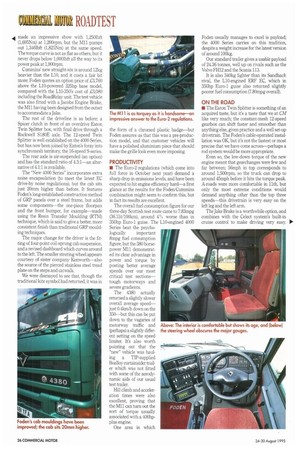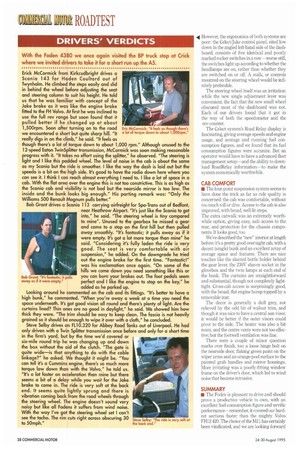GR AN
Page 26

Page 28

Page 30

Page 31

If you've noticed an error in this article please click here to report it so we can fix it.
Cummins' all-electronic Mll has finally made it to the UK, fitted to Foden's latest 4000 Series tractive unit. The new engine promises to combine Euro-2 emissions with a worthwhile gain in performance—is it all talk, or all torque?
There's a fair amount to be said for being a small-scale manufacturer: you can experiment with different components and designs, and you can be flexible enough to cater to the exact needs of each customer. The penalty is that a small turnover allows only a small development budget, so entirely new models take a long time to come to fruition.
Foden is the very model of such a small truck builder, with the twist that this British lion is owned by American giant Paccar—and like many an American truck assembler, it buys in engines, gearboxes, axles, steering and braking, saving a major part of its development costs.
The cab provides the identity of a truck, so most manufacturers go to great lengths to build their own. But this stretches the budget of a small company to the limit, dictating a long product life, and a facelift every few years. Foden's S10 cab—the heart of the latest 4000 Series—made it all the way through the eighties, and has received a new lease on life thanks to this year's facelift. Presumably we will have to wait for the 5000 Series before an
all-new cab appears, but the "New 4000 Series" incorporates many worthwhile improvements in refinement and build quality. Foden promised that it would be the first UK-market truck to have an engine that every CM tester has been eager to drive: sure enough, the firm has delivered, with Cummins' electronically controlled, low-emission, high-torque M11.
PRODUCT PROFILE • The drivetrain of this Foden relies on the holy trinity of Cummins, Eaton and Rockwell. The M11 380E engine has Celect Plus "full authority" electronic fuel injection, linked to the Road Relay information system—a £784 option on the New 4000 Series. The M1 1 is essentially a development of the 10-litre, 350horsepower L10 Celect, tested in Euro-1 form by CM a few months ago (CM 27 April-3 May) installed into this very chassis. The Mll has a longer stroke than the L10, taking capacity from 10,0 to 10.8 litres and boosting peak power from 350hp (260kW) to 376hp (279kW), while satisfying Euro-2 emissions regulations. But the crucial difference is in torque: the L10 ■
made an impressive show with 1,2501bft (1,695Nm) at 1,200rpm, but the Mll pumps out 1,3461bft (1,825Nm) at the same speed. The torque curve is not as flat as others, but it never drops below 1,0001bft all the way to its power peak at 1,900rpm.
Cummins' new straight-six is around 12kg heavier than the L10, and it costs a fair bit more: Foden quotes an option price of £3,760 above the L10-powered 325hp base model, compared with the L10-350's cost of 43,080 including the RoadRelay unit. The test vehicle was also fitted with a Jacobs Engine Brake, the M11 having been designed from the outset to accommodate a Jake.
The rest of the driveline is as before: a Spicer clutch in front of an overdrive Eaton Twin Splitter box, with final drive through a Rockwell S180E axle. The 12.speed Twin Splitter is well established on the 4000 Series, but has now been joined by Eaton's foray into synchromesh territory, the 16-speed S-series.
The rear axle is air-suspended (an option) and has the standard ratio of 4.3:1—an alternative of 4.1:1 is available.
The "New 4000 Series" incorporates extra noise encapsulation (to meet the latest EC drive-by noise regulations), but the cab sits just 20mm higher than before. It features Foden's long-established construction method of GRP panels over a steel frame, but adds some components—the one-piece floorpan and the front bumper, for example—made using the Resin Transfer Moulding (RTM) technique, which is said to give a better, more consistent finish than traditional GRP moulding techniques.
The major change for the driver is the fitting of four-point coil-sprung cab suspension, and a revised dashboard which curves around to the left. The smaller steering wheel appears courtesy of sister company Kenworth—also the source of the pierced stainless steel tread plate on the steps and catwalk We were dismayed to see that, though the traditional kite symbol had returned, it was in the form of a chromed plastic badge—but Foden assures us that this was a pre-production model, and that customer vehicles will have a polished aluminium piece that should make the grille look even more imposing.
PRODUCTIVITY • The Euro-2 regulations (which come into full force in October next year) demand a sharp drop in emissions levels, and have been expected to hit engine efficiency hard—a first glance at the results for the Foden/Cummins combination might seem to confirm this, but in fact its results are excellent.
The overall fuel consumption figure for our three-day Scottish test route came to 7.83mpg (36.11it/100km), around 4% worse than in 350hp Euro-1 guise. The L10-engined 4000 Series beat the psycho logically important 8mpg fuel consumption figure, but the 380 horsepower Mu l demonstrated its clear advantage in power and torque by posting better average speeds over our most critical test sections— tough motorways and severe gradients.
The 4380 actually returned a slightly slower overall average speed— just 0,4km/h down on the 350—but this can be put down to the vagaries of motorway traffic and (perhaps) a slightly different setting on the speed limiter. It's also worth pointing out that the "new" vehicle was hauling a TIP-supplied Boalloy curtainsider trailer which was not fitted with some of the aerodynamic aids of our usual test trailer.
Hill climb and acceleration times were also excellent, proving that the Mll can turn out the sort of torque usually. associated with a 400hpplus engine.
One area in which Foden usually manages to excel is payload; the 4000 Series carries on this tradition, despite a weight increase for the latest version of around 100kg.
Our standard trailer gives a usable payload of 24.36 tonnes, well up on rivals such as the Volvo FH12 and the Scania 113.
It is also 340kg lighter than its Sandbach rival, the L10-engined ERF EC, which in 350hp Euro-1 guise also returned slightly poorer fuel consumption (7.80mpg overall).
ON THE ROAD • The Eaton Twin Splitter is something of an acquired taste, but it's a taste that we at CM like very much; the constant-mesh 12-speed gearbox can shift faster and smoother than anything else, given practice and a well set-up drivetrain. The Foden's cable-operated installation was OK, but it's not the fastest or most precise that we have come across—perhaps a rod system would be more appropriate.
Even so, the low-down torque of the new engine meant that gearchanges were few and far between; 56mph in top corresponds to around 1,500rpm, so the truck can drop to around 45mph before it hits the torque peak. A-roads were more comfortable in 11th, but only the most extreme conditions would demand anything other than the top three speeds—this drivetrain is very easy on the left leg and the left arm.
The Jake Brake is a worthwhile option, and combines with the Celect system's built-in cruise control to make driving very easy. 0
However, the ergonomics of both systems are poor: the Celect/jake control panel, sited low down in the angled left-hand side of the dashboard, consists of five identical and poorly marked rocker switches in a row—worse still, the switches light up according to whether the headlamps are on, rather than whether they are switched on or off. A stalk, or controls mounted on the steering wheel would be infinitely preferable.
The steering wheel itself was an irritation: while the new single adjustment lever was convenient, the fact that the new small wheel obscured most of the dashboard was not. Each of our drivers found that it got in the way of both the speedometer and the rev-counter.
The Celect system's Road Relay display is fascinating, giving average speeds and engine usage, and average and running fuel consumption figures, and we found that its fuel consumption figures were accurate. But an operator would have to have a advanced fleet management setup—and the ability to download RoadRelay information—to make the system economically worthwhile.
CAB COMFORT • The four-point suspension system seems to have done the trick as far as ride quality is concerned: the cab was comfortable, without too much roll or dive. Access to the cab is also improved, with broad, well-lit steps.
The extra catwalk was an extremely worthwhile option, giving easy, safe access to the rear, and protection for the chassis components. It looks good, too.
We've described the "new" interior at length before: it's a pretty good overnight cab, with a decent (single) bunk and an excellent array of storage space and features. There are nice touches like the slanted bottle holder behind the gear lever, the 230V shaver socket in the glovebox and the twin lamps at each end of the bunk. The curtains are straightforward and substantial, though not completely lighttight. Cross-cab access is surprisingly good, with the broad, flat engine hump topped by a removable mat.
The decor is generally a dull grey, not relieved by the odd bit of walnut trim, and though it was nice to have a central sun visor, it would be better if the outer visors could pivot to the side. The heater was also a hit noisy, and the centre vents were not too effective; but the footwell ventilation was fine.
There were a couple of minor question marks over finish, too: a loose hinge bolt on the nearside door, flaking green paint on the wiper arms and an orange-peel surface to the painted grab handles and mirror housings. More irritating was a poorly-fitting window frame on the driver's door, which led to wind noise that became intrusive.
SUMMARY • The Foden is pleasant to drive and should prove a productive vehicle to own, with an excellent fuel consumption figure and terrific performance—remember, it covered our hardest sections faster than the mighty Volvo FH12 420. The choice of the Mll has certainly been vindicated, and we are looking forward to seeing Foden combine it with the S-series synchro box.
The 4000 Series' cab has been updated well, but it remains more suited to occasional overnight use than serious transcontinental travel; Foden could do with a high-roof answer to their Sandbach rivals' Olympic cab.
The Foden's baseline price is certainly attractive, but take a look at the long list of extras fitted to our test vehicle which take it up to Scandinavian levels. The choice of whether to buy British (a truck built in Britain by US-owned Foden or Swedish-owned Volvo?) must be largely down to the abilities and commercial nous of your local dealers The 4380 just goes to prove that a small manufacturer needs to make no excuses when it's up against the big boys.
Li by Toby Clark




























































































































